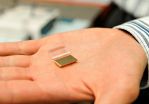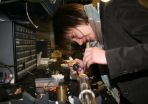Chest radiation to treat childhood cancer increases patients' risk of breast cancer
2014-10-27
(Press-News.org) A new study has found that patients who received chest radiation for Wilms tumor, a rare childhood cancer, face an increased risk of developing breast cancer later in life due to their radiation exposure. Published early online in CANCER, a peer-reviewed journal of the American Cancer Society, the findings suggest that cancer screening guidelines might be re-evaluated to facilitate the early diagnosis and prompt treatment of breast cancer among Wilms tumor survivors.
Wilms tumor is a rare childhood kidney cancer that can spread to the lungs. When this spread occurs, patients receive a relatively low dose of 12-14 Gray of radiation therapy to the entire chest. To see if such exposure to radiation affects patients' risk of developing breast cancer, Norman Breslow, PhD, of the University of Washington and the Fred Hutchinson Cancer Research Center in Seattle, led a team that studied nearly 2500 young women who had been treated for Wilms tumor during childhood and who had survived until at least 15 years of age.
Of female Wilms tumor survivors who received radiation to the chest, over 20% developed breast cancer by age 40 years (3/4 invasive, 1/4 non-invasive), in contrast to only 0.3% in female Wilms tumor survivors who did not receive radiation. The researchers also found an intermediate risk (4%) of breast cancer among female Wilms tumor patients who had received abdominal but no chest radiation as part of their treatment for Wilms tumor. The rates for females receiving chest irradiation, abdominal radiation and no radiation are nearly 30, 6, and 2 times those expected among women of comparable age in the general population. This high incidence of breast cancer, including invasive cancer, was an unexpected finding.
"Current guidelines call for early screening for breast cancer among survivors of childhood cancer if they have received 20 or more Gray of radiation therapy to breast tissue. This would exclude a large majority of patients who had received whole chest radiation for Wilms tumor," said Dr. Breslow. "Our results suggest that the risk of early breast cancer among Wilms tumor survivors is sufficiently high that early screening might be considered an option for them also."
In an accompanying editorial, Jennifer Dean, MD and Jeffrey Dome, MD, PhD of Children's National Health System in Washington, DC, noted that Wilms tumor survivors at high risk should undergo breast cancer surveillance with mammogram, breast MRI, or both starting at age 25 years. However, they pointed to research indicating that less than half of childhood cancer survivors considered to have a high risk for breast cancer follow through with surveillance guidelines. "Because compliance with breast cancer surveillance is low in adult survivors of childhood cancer, barriers such as education of both survivors and providers should be addressed and mitigated," they wrote.
INFORMATION:
ELSE PRESS RELEASES FROM THIS DATE:
2014-10-27
Today, the International Osteoporosis Foundation (IOF) has published an educational slide deck highlighting 60 original scientific abstracts presented at the Annual Meeting of the American Society for Bone and Mineral Research (ASBMR) in September 2014.
The succinct slide kit can be downloaded free of charge by all individual IOF members (free sign up on the IOF website).
CEO Judy Stenmark stated, "IOF is pleased to provide this informative resource for healthcare professionals interested in the latest advances in bone and mineral research. While 10% of the featured ...
2014-10-27
Toronto, Canada – Making mistakes while learning can benefit memory and lead to the correct answer, but only if the guesses are close-but-no-cigar, according to new research findings from Baycrest Health Sciences.
"Making random guesses does not appear to benefit later memory for the right answer , but near-miss guesses act as stepping stones for retrieval of the correct information – and this benefit is seen in younger and older adults," says lead investigator Andrée-Ann Cyr, a graduate student with Baycrest's Rotman Research Institute and the Department ...
2014-10-27
VANCOUVER ─ Different ethnic groups have widely varying differences in both the prevalence and awareness of cardiovascular risk factors, a finding that highlights the need for specially designed education and intervention programs, according to a study presented today at the 2014 Canadian Cardiovascular Congress.
The conclusion comes from a study of more than 3,000 patients at an urgent-care clinic serving an ethnically diverse area of Toronto. Participants were asked to self-identify their ethnicity and, from a list of 20 activities or conditions, asked to identify ...
2014-10-27
VANCOUVER ─ People facing mental health challenges are significantly more likely to have heart disease or stroke, according to a study presented today at the Canadian Cardiovascular Congress.
"This population is at high risk, and it's even greater for people with multiple mental health issues," says Dr. Katie Goldie, lead author of the study and a postdoctoral fellow at the Centre for Addiction and Mental Health in Toronto
Using data from the Canadian Community Health Survey, Dr. Goldie explored the associations between cardiovascular risk and disease, mental ...
2014-10-27
VANCOUVER ─ Heart surgery patients who received newly donated blood have significantly fewer post-operative complications than those who received blood that had been donated more than two weeks before their surgery, a study presented at the Canadian Cardiovascular Congress has shown.
The study examined records at the New Brunswick Heart Centre (NBHC) in Saint John for non-emergency heart surgeries performed over almost nine years, from January 2005 to September 2013, on patients who received red blood cells either during their surgery or afterwards and who stayed ...
2014-10-27
This news release is available in French.
In less than a minute, a miniature device developed at the University of Montreal can measure a patient's blood for methotrexate, a commonly used but potentially toxic cancer drug. Just as accurate and ten times less expensive than equipment currently used in hospitals, this nanoscale device has an optical system that can rapidly gauge the optimal dose of methotrexate a patient needs, while minimizing the drug's adverse effects. The research was led by Jean-François Masson and Joelle Pelletier of the university's Department ...
2014-10-26
In an analysis that included approximately 35,000 participants, genetic predisposition to elevated low-density lipoprotein cholesterol (LDL-C) was associated with aortic valve calcium and narrowing of the aortic valve, findings that support a causal association between LDL-C and aortic valve disease, according to a study appearing in JAMA. The study is being released to coincide with its presentation at the Canadian Cardiovascular Congress.
Aortic valve disease remains the most common form of heart valve disease in Europe and North America and is the most common indication ...
2014-10-26
Stanford, CA— Proteins are the machinery that accomplishes almost every task in every cell in every living organism. The instructions for how to build each protein are written into a cell's DNA. But once the proteins are constructed, they must be shipped off to the proper place to perform their jobs. New work from a team of scientists led by Carnegie's Munevver Aksoy and Arthur Grossman, describes a potentially new pathway for targeting newly manufactured proteins to the correct location. Their work is published by The Plant Cell.
The team's discovery concerns ...
2014-10-26
October 26, 2014, New York, NY – Ludwig Oxford researchers have discovered a key mechanism that governs how cells of the epithelia, the soft lining of inner body cavities, shift between a rigid, highly structured and immobile state and a flexible and motile form. Published in the current issue of Nature Cell Biology, their study shows that a tumor suppressor protein named ASPP2 functions as a molecular switch that controls this process and its reverse, both of which play a critical role in a number of biological phenomena, including wound healing, embryonic development ...
2014-10-26
PROVIDENCE, R.I. [Brown University] — Superconductors and magnetic fields do not usually get along. But a research team led by a Brown University physicist has produced new evidence for an exotic superconducting state, first predicted a half-century ago, that can indeed arise when a superconductor is exposed to a strong magnetic field.
"It took 50 years to show that this phenomenon indeed happens," said Vesna Mitrovic, associate professor of physics at Brown University, who led the work. "We have identified the microscopic nature of this exotic quantum state of ...
LAST 30 PRESS RELEASES:
[Press-News.org] Chest radiation to treat childhood cancer increases patients' risk of breast cancer

